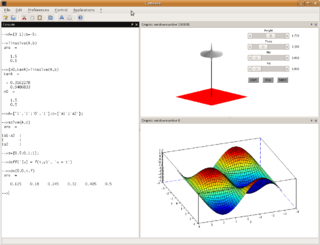
MATLAB is a multi-paradigm numerical computing environment and proprietary programming language developed by MathWorks. MATLAB allows matrix manipulations, plotting of functions and data, implementation of algorithms, creation of user interfaces, and interfacing with programs written in other languages, including C, C++, C#, Java, Fortran and Python.

Scilab is a free and open-source, cross-platform numerical computational package and a high-level, numerically oriented programming language. It can be used for signal processing, statistical analysis, image enhancement, fluid dynamics simulations, numerical optimization, and modeling, simulation of explicit and implicit dynamical systems and symbolic manipulations.
The General Data Format for Biomedical Signals is a scientific and medical data file format. The aim of GDF is to combine and integrate the best features of all biosignal file formats into a single file format.

The GNU Data Language (GDL) is a free alternative to IDL. Together with its library routines, GDL is developed to serve as a tool for data analysis and visualization in such disciplines as astronomy, geosciences, and medical imaging. GDL is licensed under the GPL. Other open-source numerical data analysis tools similar to GDL include GNU Octave, NCAR Command Language (NCL), Perl Data Language (PDL), R, Scilab, SciPy, and Yorick.
EViews is a statistical package for Windows, used mainly for time-series oriented econometric analysis. It is developed by Quantitative Micro Software (QMS), now a part of IHS. Version 1.0 was released in March 1994, and replaced MicroTSP. The TSP software and programming language had been originally developed by Robert Hall in 1965. The current version of EViews is 10, released in June 2017.
The following tables provide a comparison of numerical-analysis software.
In numerical analysis, the Dormand–Prince (RKDP) method or DOPRI method, is an explicit method for solving ordinary differential equations. The method is a member of the Runge–Kutta family of ODE solvers. More specifically, it uses six function evaluations to calculate fourth- and fifth-order accurate solutions. The difference between these solutions is then taken to be the error of the (fourth-order) solution. This error estimate is very convenient for adaptive stepsize integration algorithms. Other similar integration methods are Fehlberg (RKF) and Cash–Karp (RKCK).
ARPACK, the ARnoldi PACKage, is a numerical software library written in FORTRAN 77 for solving large scale eigenvalue problems in the matrix-free fashion.
Isogeometric analysis is a recently developed computational approach that offers the possibility of integrating finite element analysis (FEA) into conventional NURBS-based CAD design tools. Currently, it is necessary to convert data between CAD and FEA packages to analyse new designs during development, a difficult task since the computational geometric approach for each is different. Isogeometric analysis employs complex NURBS geometry in the FEA application directly. This allows models to be designed, tested and adjusted in one go, using a common data set.
This is a list of free and open-source software for geophysical data processing and interpretation. The list is split into broad categories, depending on the intended use of the software and its scope of functions.

20-sim is commercial modeling and simulation program for multidomain dynamic systems, which is developed by Controllab. With 20-sim models can be entered as equations, block diagrams, bond graphs and physical components. 20-sim is widely used for modeling complex multi-domain systems and the development of control systems.
IT++ is a C++ library of classes and functions for linear algebra, numerical optimization, signal processing, communications, and statistics. It is being developed by researchers in these areas and is widely used by researchers, both in the communications industry and universities. The IT++ library originates from the former Department of Information Theory at the Chalmers University of Technology, Gothenburg, Sweden.





